Project Triple Jump: New levels of education and inspiration in Houston
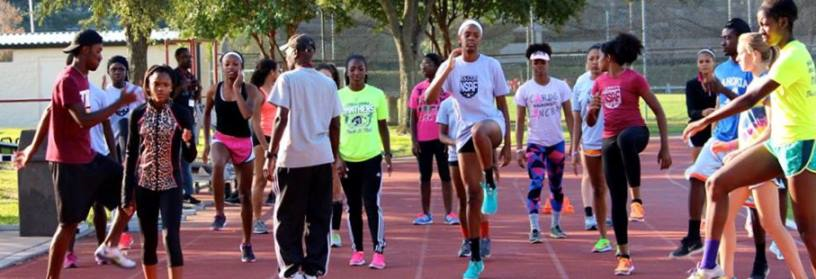
Warmups and drills at the St. John's track. All photos by Joy Kamani.
The annual cycle of change is one of the exciting and gratifying things each year about the National Scholastic Athletic Foundation’s Performance Clinics and Camps – watching the seniors move on to the collegiate level, seeing the returnees mature and become leaders, and welcoming newcomers to the fold. And, in this case, “cycle of change” also meant a new city and clinic venue … and the opportunity for presentations to our athletes from world-class legends of the triple jump and a world-class nutritionist, as well!
So, this is what went down as Project Triple Jump began its fourth season last month (Oct. 16-19) – led by Head Coach Peter Pratt and Project Coordinator and Coach Macka Jones:
- We said “Hello!” to newcomers Allyson Weiss, Jordyn Lesh and Saudia James-Heard! Allyson, an East Ridge (Woodbury, MN) frosh, had been to our clinics before and was invited to join the Project this past summer after a 37-9.5 at NBNO as an 8th-grader. Jordyn is a sophomore at Harpeth Hall in Nashville; as a freshman she hit a PR 38-9.5 at USATF JOs (15-16s). And Saudia is a freshman at Curtis HS (Lakewood, WA) who just took up the event this past spring and a few months later set a USATF JO national meet record (13-14s) at 38-8.75. See NEWCOMERS story
- We said “Welcome back!” to Project returnees Felicienne Axel, Chinne Okoronkwo, Ja’Mari Ward, Nashedah Mumin and Arielle Mack. “Faye” is a two-time Texas 3A champ who is starting her third year in the Project, while the other four are all starting their second years. All had varying degrees of success in the 2014 indoor and outdoor seasons, with Chinne and Ja’Mari emerging as the top sophomore triple jumpers in the country. Both placed high in major meets all year, earning All-American rankings, with Chinne winning the Youth Olympic Trials and earning a chance to compete in China. See RETURNEES AND GRADUATES story
- We said “Thank you!” to those who led our outstanding classroom sessions. They included renowned dietician Dr. Roberta Anding, the Director of Sports Nutrition at Texas Children's Hospital and nutritionist for the Houston Texans and Astros, and triple jump luminaries Frank Rutherford (1992 Olympic bronze medalist and 3-time Olympian), Terri Turner-Hairston (4-time world record-setter in the 1980s), Sanya Owolabi (prep national record-setter in the 1970s) and Paul Jordan (1980 Olympian and 3-time Trials participant). See BELOW
- We also said, “Hello!” to The St. John’s School in Houston – an independent institution with an outstanding track and field facility – as well as Houston-area club Coach Walter Walls and more than 30 other student-athletes who registered and attended our event.
- And, finally, we’ll use this space to say “Good bye and good luck” to our graduated seniors – now in the collegiate ranks – who piled up numerous and memorable state, national and international honors during their five combined seasons with us: Keturah Orji, KeAndre Bates and Darrielle McQueen. See RETURNEES AND GRADUATES story
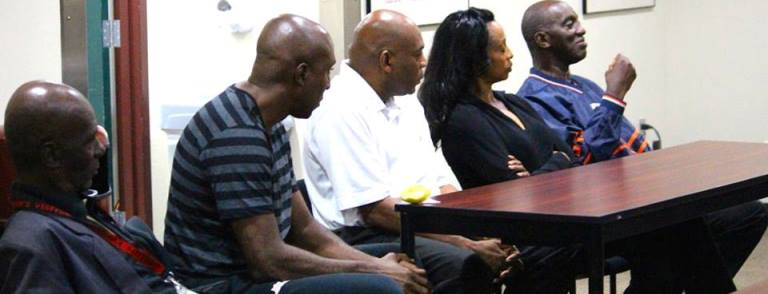
From left: Coach Pratt, Frank Rutherford, Sanya Owolobi, Terri Turner-Hairston, Paul Jordan.
Incredible opportunities for education and inspiration
All of the Project Triple Jump clinics and camps since the program’s inception have featured outstanding coaching and training from Coaches Pratt and Jones, as well. There have typically been guest speakers, as well, such as U.S. Olympic medalist Will Claye at the Chula Vista session this past summer. But this recent Houston clinic set new standards for both educational and inspirational opportunities as the athletes had a chance to learn from  one of the nation’s top nutritionists and listen to not one, not two, but four of the event’s all-time greats as guest speakers.
one of the nation’s top nutritionists and listen to not one, not two, but four of the event’s all-time greats as guest speakers.
For an thorough and “easy to digest” educational presentation on hydration and nutrition, Project TJ was blessed to have Dr. Roberta Anding, MS, RD/LD, CDE, CSSD and Director of Sports Nutrition at Texas Children’s Hospital – where she is “providing nutritional guidance for athletes and adolescents with eating disorders or other complex medical nutritional concerns.” Dr. Anding, whose credentials over more than 30 years are deep and broad, is also a sports dietician at Rice University, as well as filling the same role for the NFL’s Houston Texans and MLB’s Houston Astros. She also has intimate experience with track and field athletes, as her son Kevin is a 46.37 400-meter runner.
Dr. Anding’s presentation first covered many basics and details of proper hydration for athletes, including training and competition scenarios, as well as everyday athletic life. Some of the information was common sense or at least widely known, but her emphasis on gaging one’s hydration by tracking body weight and the color of one’s urine, for example, was revelatory to many. “The digital scale is your best friend,” she said. “If you lose one pound (during a training or competitive session), that’s 16 ounces of water you didn’t replace.” She went on to talk about sodium depletion, the “potassium myth” and the “swish and spit” option, among other things.”
In the “food” portion of the presentation, Dr. Anding’s focus was on “building a performance plate” and “maintaining your fuel tank.” Beyond dispensing just simple dietary information, she focused on “game day nutrition” and “post-game/recovery nutrition.” There was important information about balancing carbohydrates and proteins, being mindful of perishable proteins when stocking a gym bag for a full day (or more) of training and/or competition, and making the right choice in fast food restaurants and other on-the-road scenarios … and so much more. She also directed the kids toward scandpg.org, for additional information.
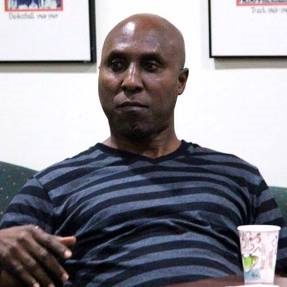 Earlier, in a session on the opening evening of the clinic, the Project Triple Jump athletes had the bounty listening to and learning from four legendary figures in their favorite event: Frank Rutherford, Terri Turner-Hairston, Sanya Owolabi and Paul Jordan.
Earlier, in a session on the opening evening of the clinic, the Project Triple Jump athletes had the bounty listening to and learning from four legendary figures in their favorite event: Frank Rutherford, Terri Turner-Hairston, Sanya Owolabi and Paul Jordan.
Considered by many “the father of track and field in the Bahamas,” Rutherford is a 3-time Olympic triple jumper and winner of the bronze medal in the 1992 Games in Barcelona. He also captured the Bahamas’ first-ever World Championship medal with the 1987 Indoor TJ bronze. Rutherford is a University of Houston alum, where he won 3 NCAA titles and is still the school-record holder in the event. His Frank Rutherford Foundation was started to give young Bahamians the opportunity to get a college education through academic and sports.
Rutherford spoke of developing that passion for track and field, and later the triple jump, in the Bahamas – where “track and field happens to be our NBA, our NFL or our Major League Baseball.” It started when he was just four years old and by age five he wanted to win a gold medal. Once he was introduced to the TJ, he would learn that it’s the “most beautiful work of art there is … when it’s done the right way.” He detailed the work ethic he became famous for, learning from slightly older contemporary Lyndon Sands and Coach Tom Tellez (“the greatest track coach ever”), and a “gift for listening to older people” in general. The triple jump, Rutherford said, is not just a track and field event, but “a sport … truly our (The Bahamas’) national sport.”
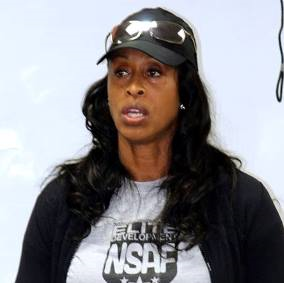 Turner-Hairston was one of the early legends of the triple jump on the women’s side, setting four world records between 1981 and 1984. Amazingly, the first two came in 1981 and 1982 – her junior and senior years at New Caney HS – as she became the 2nd woman in history to break 40 feet and won the 2nd and 3rd of her Texas state TJ titles. Back then, the TJ was not an official IAAF event or an Olympic event. At the University of Texas, Turner was a point-scoring machine while winning two NCAA titles and setting two more WRs – the last being a 43-4.25 in 1984. She’s now a coach at Houston’s Kincaid School.
Turner-Hairston was one of the early legends of the triple jump on the women’s side, setting four world records between 1981 and 1984. Amazingly, the first two came in 1981 and 1982 – her junior and senior years at New Caney HS – as she became the 2nd woman in history to break 40 feet and won the 2nd and 3rd of her Texas state TJ titles. Back then, the TJ was not an official IAAF event or an Olympic event. At the University of Texas, Turner was a point-scoring machine while winning two NCAA titles and setting two more WRs – the last being a 43-4.25 in 1984. She’s now a coach at Houston’s Kincaid School.
Turner first related how being beaten by other kids on the bus home when she was young led her to seeking out after-school sports – at first, basketball – and discovering talent and reasons to feel good about herself. “Sometimes things happen for a reason,” she said. “I was good and I was no mistake.” It wasn’t long before she found track and field and, eventually, came to love the triple jump best – even though she had extremely wide-ranging talents. “My favorite always has been and always will be the triple jump,” she said.
Turner’s dad challenged her, particularly to keep tabs on her rivals and know “who’s ahead of you this week.” She soon figured out that she didn’t have to know who was ahead of her … if she was the best. Her dad would also put pins in a map to represent any city, state or beyond where she was the best, and Turner recalled how once when she set a triple jump world record she brought home a globe to her dad, so he could stick in pin in that. “He still has that globe,” she said. Wrapping up, she encouraged the kids not to listen to negative influences in the world, or believe negative things others might say about them, and to “let it be ok that you set yourself aside to be different” – while taking care of oneself on the path to excellence.
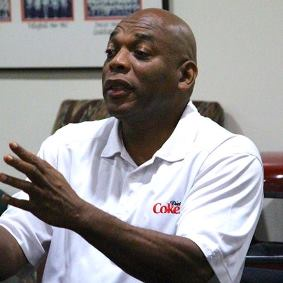 Owolabi was the national prep athlete of the year from Sleepy Hollow, NY in 1978 after setting the triple jump HSR at 53-4.25 – still #7 all-time. His major triumphs included a 52-2.75 at the Penn Relays, still the meet record, and he was a “Wall of Fame” inductee in 1999 there. Later at the U. of Kansas, he won the 1980 NCAA indoor title and had two more runner-up finishes in and out. Nerve problems in his leg, however, forced him to retire in 1984.
Owolabi was the national prep athlete of the year from Sleepy Hollow, NY in 1978 after setting the triple jump HSR at 53-4.25 – still #7 all-time. His major triumphs included a 52-2.75 at the Penn Relays, still the meet record, and he was a “Wall of Fame” inductee in 1999 there. Later at the U. of Kansas, he won the 1980 NCAA indoor title and had two more runner-up finishes in and out. Nerve problems in his leg, however, forced him to retire in 1984.
Owolobi shared some similar sentiments as Turner, like having low self-esteem before he discovered track and field. He talked about discovering the sport, then the TJ itself in an early dual meet. “I had no idea how to do it, I just knew we needed points,” he said. The triple jump turned out to be a “natural” event for Owolobi and even by his soph year at Sleepy Hollow he was the state record holder.
Again, like Turner and Rutherford, he talked about knowing “who’s in front of you” – he recalled competing against future NFL Hall of Famer Art Monk – and having that “burning passion to succeed.” In life after track and field, he concluded, “the things you learn carry you on … Track and field has carried me to this day … what I want you to understand is that the goals you set now, the standards you put for yourself, will be something that will carry you for the rest of your life.”
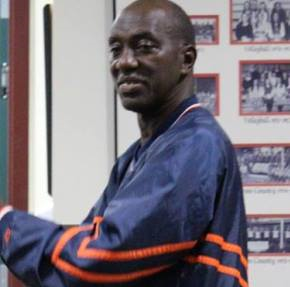 As the final speaker, Jordan wasn’t one of those who could claim world or high school records, or an Olympic medal. But he was high in the mix at every level and perhaps overflowed with triple jump passion more than anyone – no mean feat considering who came before him. A 56-4 performer in his career, Jordan made the 1980 Olympic team when he finished 2nd in the Trials. But the U.S. didn’t go to the Olympics that year due to a boycott. He also competed in the 1976 and 1984 Trials. Some of his other honors included two Penn Relay TJ titles during his All-American career at Tennessee and, earlier, a USATF Junior title.
As the final speaker, Jordan wasn’t one of those who could claim world or high school records, or an Olympic medal. But he was high in the mix at every level and perhaps overflowed with triple jump passion more than anyone – no mean feat considering who came before him. A 56-4 performer in his career, Jordan made the 1980 Olympic team when he finished 2nd in the Trials. But the U.S. didn’t go to the Olympics that year due to a boycott. He also competed in the 1976 and 1984 Trials. Some of his other honors included two Penn Relay TJ titles during his All-American career at Tennessee and, earlier, a USATF Junior title.
Jordan recalled his coach teaching him the TJ at 15, while at Philly’s Overbrook HS. “That started the love and passion,” he said, “the passion that carried me through life … passion is that glue that holds you together through effort, trials and tribulations, takes you past the hurt and pain and takes you to the next level.” At least twice during his presentation, he physically broke into spontaneous triple jump phases – as if he was itching to compete right then and there – much to the delight of the audience. “The technique just stays with you,” he laughed. “The feeling you get running down the runway, going through the phases … I’ve been infected by it and I want you to be infected by it.”
As did the other speakers, Jordan has a profound appreciate for the history of the event, his forerunners, his peers and rivals. He talked about competing locally in Philly in the 70s with Penn Relays champ Ron Livers. “We won back-to-back U.S. Junior titles,” he said. “I couldn’t take a week off.” Clearly, he soaked in everything during his career – the opportunity for a scholarship (“I got a college education because I could triple jump,” he marveled), talking with and learning from every other jumper that he could, always taking all six of his jumps. “I had the attitude of never die,” he said, “I thought I could jump further than anyone who ever walked.” It wasn’t arrogance, it was passion. Being the most talented wasn’t the key, but it was “attitude and belief, if you have that, no way you won’t improve and you’ll have fun … you’ve got an opportunity to take what God has given you.”




